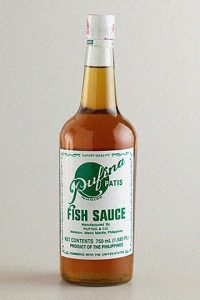
“It started with a nipa hut, some earthen jars, and a vision.”

A black-and-white print ad released in 1968 describes the humble beginnings of Rufina Patis. These three components led to the success of the fish sauce company
that remains to be in business for over a century. A nipa hut served as its makeshift factory; earthen jars were used in the preservation process; and a sterling vision brought a humble fish by-product into global fame.
In northern Metro Manila is the coastal city of Malabon. Its location, adjacent to Navotas, proved beneficial in creating a vital port and fish trading center in the area. Locals delighted in the bounty presented by the sea.
One of them is Rufina Salao viua de Lucas, a fish dealer, who pioneered the making of patis in 1900. At a time when refrigeration was not yet available, most depended on salting and curing as a way of preserving food. The widow did in the hope of preserving fish throughout the months of summer.
Rufina preserved fresh fish by making bagoong. Fish is mashed and combined with salt, then stored in earthen jars, called tapayan, to ferment. The product is a thick, salty paste that is heady and almost too stinky for the uninitiated. She noticed that a clear juice was secreted by the raw mixture during fermentation. She took this to her kitchen, experimented with it, and brought to life what is now known as patis.
The accidental fish sauce turned out to be a hit not only among her friends and family but also by the townsfolk. With a capital of 50 pesos, she started producing a lot more to meet the demand and consequently making Rufina Patis a household name and a viable export product.
It started with a nipa hut, some earthen jars, and a vision.
Before 1941, Rufina converted her earthen jars into wooden barrels, more capable of storing the fish sauce and allowing for natural filtration. The patis turned out to be clearer, more potent, and free of impurities.
Demand grew after the war and the barrels had to be replaced with concrete vats. This allowed production to increase and distribution to diversify. Rufina Patis became more accessible in supermarkets all over the country.
In 1957, her namesake company opened its very first processing and bottling plant along C. Arellano Street in Malabon. The following year, Rufina’s son, Jesus, visited the United States and discovered the untapped potential to export their family’s product overseas, especially targeting Filipino communities hankering for a taste of home. Numerous samples were submitted to the approving agencies. Eventually, Rufina Patis was granted approval for sales in the United States.
Rufina passed away in 1961, paving way for her son to take over the company. Jesus brought Rufina Patis to farther destinations.

Rufina Patis opened a second processing and bottling plant along Bonifacio Street, still in Malabon. And as production increased, the fish sauce also reached other corners of the world, including Canada, Australia, the Middle East, Europe, and Hong Kong.
The legacy of Rufina, both the company and its pioneering visionary, remains to this day. The patis is favored for its unadulterated quality and hygienic production process. Fish and salt remain to be its key components.
In Cebu, Bacolod, or Surigao, ask for patis and you will receive soy sauce. But ask for Rufina and you are rewarded with liquid gold.


Recent Comments